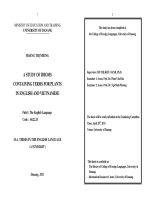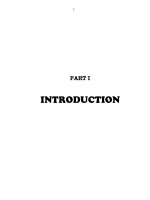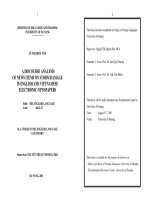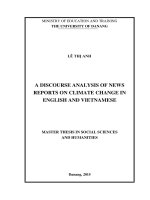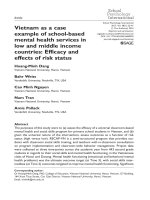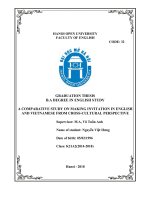A COGNITIVE STUDY OF METAPHORS BASED ON HUMAN SENSES IN ENGLISH AND VIETNAMESE
Bạn đang xem bản rút gọn của tài liệu. Xem và tải ngay bản đầy đủ của tài liệu tại đây (658.48 KB, 27 trang )
<span class="text_page_counter">Trang 1</span><div class="page_container" data-page="1">
<b>THE UNIVERSITY OF DANANG </b>
<b>TRẦN THỊ THÙY OANH </b>
<b>A COGNITIVE STUDY OF METAPHORS BASED ON HUMAN SENSES IN ENGLISH AND VIETNAMESE </b>
<b>Major: English Linguistics </b>
</div><span class="text_page_counter">Trang 2</span><div class="page_container" data-page="2">The thesis has been completed at The University of Da Nang.
<b>Supervisors: 1. Dr. Trần Quang Hải </b>
2. Prof. Dr. Nguyễn Văn Hiệp
Examiner 1: Prof. Dr. Nguyễn Hòa
Examiner 2: Assoc. Prof. Dr. Trương Viên
Examiner 3: Dr. Nguyễn Thị Quỳnh Hoa
The thesis was be orally defended at the Examining Committee Time: March 3<sup>rd</sup>. 2018
Venue: The University of Da Nang
This thesis is available for the purpose of reference at: - The Information Resources Center, The University of Da Nang - National Library of Viet Nam
</div><span class="text_page_counter">Trang 3</span><div class="page_container" data-page="3"><b>CHAPTER 1: INTRODUCTION 1.1. Rationale </b>
In recent years, there have been many pieces of research done in the light of cognitive linguistics with focus on metaphors based on human body parts. This is understandable because human body parts are very specific, very close to our lives and our understanding. Clearly, we experience the world with ourselves and reflect the development path of our awareness by expressing ideas from concrete to abstract. By exposing ourselves with the changes we experience every day, we seemingly receive knowledge signaled by parts of our body in one way or another. In Kövecses‟ terms (2010), “the human body is an ideal source domain, since, for us, it is clearly delineated and (we believe) we know it well” (p. 18). Actually, the ways in which HSs are used for expressing meaning in communication are so various that they can cause misunderstanding amongst language users, especially those using English as a foreign language in Vietnam. However, there have not yet been any pieces of research done on CMs based on human senses (HSs) in detail, especially in English in comparison and in contrast with Vietnamese.
<i><b>For these reasons, a study entitled “A Cognitive Study of Metaphors </b></i>
<i><b>Based on Human Senses in English and Vietnamese” has been </b></i>
conducted. It is hoped that the thesis could provide better insight into the arena of the CL in general and contribute to the practice of English teaching and learning and of translation work in Vietnam.
<b>1.2. Aims of study </b>
This thesis aims to extend the recent semantic concepts of CMs drawing from cognitive linguistic concepts that are relevant and viable to the study through tracking its history and development. Specifically, by analyzing the MEs based on the five basic HSs in English and Vietnamese, this thesis will find out the mappings between concrete domains and more abstract conceptual domains (CDs) for setting up the CMs. At the same time, the study seeks to look more closely at the universality of such models within the
<i>source domains (SDs) of the five basic HSs of vision, hearing, touch, </i>
</div><span class="text_page_counter">Trang 4</span><div class="page_container" data-page="4"><i>smell and taste as well as to find which patterns are unique for CMs </i>
in each language. In particular, the study will point out which SDs share target domains (TDs) and the possible “cross-expressions” between these senses.
<b>1.3. Objectives of the study </b>
To achieve the above aims, the following objectives are set: - to identify the MEs based on the basic HSs in English and Vietnamese;
- to examine the semantic features embodied by means of these five basic HSs in the light of CL;
- to set up the mappings or sets of correspondences with SDs and TDs to construct CMs based on HSs in both languages;
- to clarify the similarities and differences in the mapping of CMs based on HSs in both languages;
- to examine whether there are cases of SDs sharing TDs in English and Vietnamese;
- to explore the possible “cross-expressions” between the five basic human senses in the process of meaning making;
- to suggest implications for language study, for the teaching and learning of English, and for the practice of translation in Vietnam.
<b>1.4. Research questions </b>
The study aims to answer the following research questions: (1) What CMs based on the five basic HSs are constructed in English and Vietnamese?
(2) In what aspects do English and Vietnamese CMs based on the five basic HSs overlap?
(3) Which SDs share TDs in English and Vietnamese? (4) What are some “cross-expressions” between the five basic HSs in the meaning making process?
<b>1.5. Scope of the study </b>
In this thesis, we limit the study to the basic and primary
<i>human senses: vision, hearing, touch, smell, and taste embodied by </i>
metaphorical expressions which are derived from English and
</div><span class="text_page_counter">Trang 5</span><div class="page_container" data-page="5">Vietnamese novels and short stories published since the year 2000. Because of time and space as well as knowledge constraints, this analysis focuses on the semantic features.
<b>1.6. Significance of the study </b>
Theoretically, the study supplements some more illustrative evidence from English and Vietnamese to the original theory of metaphors in the view of CL.
Practically, the study provides a systematic description, analysis, comparison and contrast of the CMs based on the five basic HSs in English and Vietnamese in the light of CMT. The study has found 19 CMs constructed in both languages and has also revealed a number of cross-cutting CMs based on the five basic HSs between English and Vietnamese. Notably, the thesis has illuminated the possibility of the SDs sharing TDs in the CMs as well as the “cross-expressions” of the five basic HSs in the process of meaning making.
<b>1.7. Organization of the study </b>
The thesis consists of 7 chapters: Chapter 1 – Introduction
Chapter 2 – Literature Review and Theoretical Background Chapter 3 – Research Methodology
Chapter 4 – Conceptual Metaphors Based on Human Senses in
<i><b>2.1.1. The concepts of cognitive linguistics </b></i>
Cognitive linguistics (CL) is considered as “the school of linguistics within cognitive science” when language creation, learning and usage are conceived as “a part of a larger psychological theory of how humans understand the world” (Jackendoff, 2007 p.
</div><span class="text_page_counter">Trang 6</span><div class="page_container" data-page="6">192) or “a modern school of linguistic thought with formal approaches to language” (Evans & Green, 2006, p. 5).
<i><b>2.1.2. Main tenets in Cognitive Linguistics </b></i>
<i>One of the main tenets of CL is embodiment. To turn the second main idea, CL is related to the theory of linguistic meaning. An additional tenets of the cognitive linguistics approach is human </i>
<i>cognition. </i>
<b>2.2. Conceptual metaphor </b>
<i><b>2.2.1. The views of conceptual metaphor </b></i>
Metaphor is not a product merely associated with literary language but a product of human cognition, it is found everywhere in language and is a background which helps people understand what is named novel metaphorical expressions in distinction from conventional metaphors.
<i><b>2.2.2. Related concepts </b></i>
Some related definitions on CM to support a background for the thesis are given such as Conceptual domain, Source domain, Target domain, Mappings, Conceptualization, Conceptual structure, Image-schema and Domain matrix.
<b>2.3. Human senses </b>
<i><b>2.3.1. The concepts of human senses </b></i>
Human senses are considered as channels providing information about the external world, help human beings to perceive surrounding environment.
<i><b>2.3.2. Vision </b></i>
<i>Vision is the faculty or state of being able to see, is the ability </i>
to think about or plan the future with imagination or wisdom, is an experience of seeing someone or something in a dream or trance.
<i><b>2.3.3. Hearing </b></i>
<i>Hearing is possible is possible to locate the source and </i>
direction of stimulus, where sounds are coming from, even if the
</div><span class="text_page_counter">Trang 7</span><div class="page_container" data-page="7">object that emits the sound is far away from us, and even if we cannot perceive with our eyes, we can still hear it.
<i><b>2.3.4. Touch </b></i>
<i>Touch is defined as “coming into or being in contact with, </i>
handling in order to interfere with, altering or otherwise affecting, affecting or concerning, producing feelings of affection, gratitude, or sympathy in, reaching (a specified level or amount)”.
<i><b>2.3.5. Smell </b></i>
We must recognize that, from all senses, while vision is the one that is by far the most commonly used to objectively describe
<i>what one perceives, smell is the least developed sense in humans. It </i>
cannot be interpreted similarly to the stimulus for vision or hearing.
<i><b>2.3.6. Taste </b></i>
<i>Taste expresses the conscious experience of human, is her/his </i>
tastes.
<b>2.4. Metaphor in literature </b>
According to Kövecses (2010), one of the startling discoveries of work on poetic language by cognitive linguists is the recognition that most poetic language is based on conventional, ordinary conceptual metaphors.
<b>2.5. Related research </b>
<i><b>2.5.1. A general review </b></i>
There are indeed many works on CL, especially on conceptual metaphor - one of the salient achievements of this approach. Many typical authors with the works of metaphor in the view of CL can be remarked.
<i><b>2.5.2. The typical related works in English </b></i>
Thesis focuses on the typical work sof Lakoff and Johnson (1980/2003), Sweetser (1990), Ibarretxe-Antano (1999c), Kưvecses (2002/2010).
<i><b>2.5.3. The typical related works in Vietnamese </b></i>
There are some authors of Vietnamese sharing the general approach to CL such as Tran, C.V (2007), Nguyen, T.V (2009), Trinh, H. T. T. (2011), Nguyen, Q. T. (2015), etc.
</div><span class="text_page_counter">Trang 8</span><div class="page_container" data-page="8"><b>2.6. Chapter Summary </b>
This chapter presented for the initial ideas of CL and CM as well as related definitions.
<b>CHAPTER 3: METHODOLOGY 3.1. Research design </b>
<i><b>3.1.1. Data collection </b></i>
(1) collected the novels and stories in English and Vietnamese published officially since the year 2000;
(2) read the whole of these novels and stories and highlighted all the expressions based on the five human senses manually;
(3) calculate the expressions for each sense as well as each mapping with the function of the excel software.
<i><b>3.1.2. Data analysis </b></i>
After separating all the related data into each excel worksheet of each sense as presented above, examining the contexts to consider if their meanings are concrete or abstract in the view of CL with the OALD and VD is conducted for ensuring the accuracy on meaning of the found words and phrases and to prepare for explaining and analyzing in the following chapters.
<i><b>3.1.3. Metaphor identification </b></i>
The study followed the metaphor identification of the Pragglejaz Group (MIP) cited in Kövecses (2010, p. 5).
<b>3.2. Research Methods </b>
<i><b>3.2.1. Descriptive Method </b></i>
We used the descriptive method for describing the data collected to set up a foundation for analysis in clarifying the role of a certain lexeme in the frequency found, the way to convey the meanings of conceptual metaphors based on human senses in one language.
<i><b>3.2.2. Analytic and Synthetic Methods </b></i>
These methods were also integrated to consider conceptual metaphors based on the five basic human senses from the expressions in each language.
</div><span class="text_page_counter">Trang 9</span><div class="page_container" data-page="9"><i><b>3.2.3. Qualitative and Quantitative Methods </b></i>
The quantitative research was also used in dealing with metaphors extracted from about 700 metaphorical expressions based on the five basic human senses in each language, which vary in length but are selectively chosen.
<i><b>3.2.4. Comparative and Contrastive Methods </b></i>
The notions of conceptual metaphors based on human senses were first described and analyzed in English and then they were mainly adapted to deal with those in Vietnamese by these two methods.
<i><b>3.2.5. Deductive and Inductive Methods </b></i>
The deductive method is used to deduce many previous works of the cognitive linguists and give a framework for the study.
<b>3.3. Reliability and Validity </b>
The criteria for collecting the data defined, we chose the data sources for the study because of our great interest in literature. Besides, they must be published officially and authoritative works in America and Vietnam.
<b>3.5. Chapter Summary </b>
This chapter presented the Methodology of the thesis.
<b>CHAPTER 4: CONCEPTUAL METAPHORS BASED ON HUMAN SENSES IN ENGLISH </b>
Regarding the title of thesis, we use the same analysis strategy format in comparing and contrasting both languages. In this chapter, we are setting up the mappings for the conceptual metaphors called “the systematic set of correspondences” for each sense in English.The analysis shares the principles of previous works by Lakoff and Johnson (1980/2003) and Kövecses (2002/2010).
<b>4.1. Conceptual Metaphors based on Vision </b>
<i>A total of 311/690 metaphorical expression based on vision are </i>
divided according to four conceptual metaphors in which we pay attention to VISION as a source domain. The conceptual metaphors found include AN INTELLECTUAL ACTIVITY IS VISION,
</div><span class="text_page_counter">Trang 10</span><div class="page_container" data-page="10">AWARENESS IS VISION, JUDGMENT IS VISION and HUMAN EMOTION IS VISION. We can see the summary in Table 4.1.
<b>Table 4.1. Distribution of CMs based on Vision in English </b>
<small>1. AN INTELLECTUAL ACTIVITY IS VISION 229 73.63 </small>
The metaphor JUDGMENT IS VISION is the least-used one with 16, which stands only 5.15%, quite rare in this data.
<b>4.2. Conceptual Metaphors based on Hearing </b>
<i>From 144 metaphorical expressions based on hearing, we set </i>
up three conceptual metaphors whose target domains are abstract concepts, as AN INTELLECTUAL ACTIVITY, HUMAN EMOTION and AWARENESS. They are analyzed respectively in
<i><b>the following sections. These are summarized in Table 4.2. </b></i>
<b>Table 4.2. Distribution of CMs based on Hearing in English </b>
<small>1. AN INTELLECTUAL ACTIVITY IS HEARING 110 76.39 2. GETTING INFORMATION IS HEARING 26 18.06 </small>
The above table 4.2 shows that most of the metaphorical expressions based on hearing are shared by the metaphor AN INTELLECTUAL ACTIVITY IS HEARING.
<b>4.3. Conceptual Metaphors based on Touch </b>
From 184 metaphorical expressions based on touch, we set up two conceptual metaphors including AN INTELLECTUAL ACTIVITY IS TOUCH and HUMAN EMOTION IS TOUCH whose target domains are abstract concepts analyzed in the following
<i><b>sections. These are summarized in Table 4.3. </b></i>
</div><span class="text_page_counter">Trang 11</span><div class="page_container" data-page="11"><b>Table 4.3. Distribution of CMs based on Touch in English <small>Conceptual metaphors ME (…/184) </small><sup>Numbers of </sup></b>
As has been summarized in Table 4.3, it is found that there exist great differences between the conceptual metaphors in English touch expressions.
<b>4.4. Conceptual Metaphors based on Smell </b>
In comparison with the other senses, smell is generally considered a weaker source domain for metaphorical meanings. We set up three conceptual metaphors from 36 metaphorical expressions, with the result in Table 4.4.
<b>Table 4.4. Distribution of CMs based on Smell in English <small>Conceptual metaphors </small><sup>Numbers of </sup><small>ME (…/36) </small><sup>Percentages </sup><small>(%) </small></b>
The conceptual metaphor AN INTELLECTUAL ACTIVITY IS SMELL as its specific linguistic instantiation.
<b>4.5. Conceptual Metaphors based on Taste </b>
The sense of taste is most closely associated with fine discrimination. We summarize them in Table 4.5 as follows.
<b>Table 4.5: Distribution of CMs based on Taste in English <small>Conceptual metaphors </small><sup>Numbers of ME </sup><small>(…/15) </small><sup>Percentages </sup><small>(%) </small></b>
The LANGUAGE IS TASTE conceptual metaphor has the higher rate than the EXPERIENCE IS TASTE (60% and 40% respectively).
<b>4.6. Chapter Summary </b>
We set up 14 conceptual metaphors including four conceptual metaphors for vision (311 metaphorical expressions), three for
</div><span class="text_page_counter">Trang 12</span><div class="page_container" data-page="12">hearing (144), two for touch (184), three for smell (36) and two for taste (15). It is summarized in Table 4.6 as follows.
<b>Table 4.6. Distribution of CMs based on HSs in English </b>
All the metaphorical expressions whose target domains are abstract concepts are divided into the conceptual metaphors. The following is the specific illustration of the most popular vision and hearing metaphorical expressions, especially in the target domain AN INTELLECTUAL ACTIVITY in the vision, hear and touch from the number 100 and above. In fact, intellectual activity is linked to human senses making it a blend of conceptualization.
Now we use the same analysis format for the analysis of the Vietnamese data in the following chapter.
</div><span class="text_page_counter">Trang 13</span><div class="page_container" data-page="13"><b>CHAPTER 5: CONCEPTUAL METAPHORS BASED ON HUMAN SENSES IN VIETNAMESE </b>
As presented, this study aims to find out conceptual metaphors based on five human senses in English and Vietnamese. Therefore, we used the same analysis strategy format for setting the mappings for conceptual metaphors in English for analyzing Vietnamese data.
<b>5.1. Conceptual Metaphors based on Vision </b>
In Vietnamese, we also found four targets for the source VISION as in English, they are: AN INTELLECTUAL ACTIVITY, HUMAN EMOTION, MEETING and JUDGMENT with 379 metaphorical expressions. We summarize them in Table 5.1.
<b>Table 5.1: Distribution of CMs based on Vision in Vietnamese </b>
Table 5.1 shows the most-used group of conceptual metaphors
<i>based on vision in Vietnamese is AN INTELLECTUAL ACTIVITY </i>
IS VISION.
<b>5.2. Conceptual Metaphors based on Hearing </b>
The most special representative of hearing is „nghe‟ (hear) which has a various combination with parts of speech to produce a large number of metaphorical expressions in life. Notably, the conceptual metaphors, which are set up in English, with the targets AN INTELLECTUAL ACTIVITY, INFORMATION and HUMAN EMOTION with 108 expressions. We found 104 metaphorical expressions as summarized in Table 5.2.
<b>Table 5.2. Distribution of CMs based on Hearing in Vietnamese </b>
<small>2. GETTING INFORMATION IS HEARING 35 32.41 </small>
</div>


